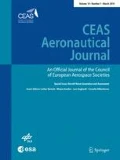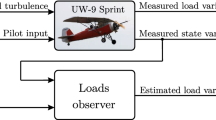Abstract
Flight testing of aircraft with altered aerodynamic configuration is a safety critical and time consuming task. For the evaluation of the aircraft characteristics under SLD icing conditions, flight tests with artificial ice shapes were performed. These flight tests were supported by online algorithms for the estimation of aerodynamic parameters. Results were available in near real-time onboard the aircraft or already during the debriefing on ground. Pre-flight data from wind tunnel experiments could be confirmed already during the flight using these online analysis tools, thus the flight tests could be performed in shorter time and more safe. This paper will introduce the developed analysis tools and will present results from the flight test campaign.

















Similar content being viewed by others
Abbreviations
- \(a_{x} ,a_{y} ,a_{z}\) :
-
Translational accelerations along the body axes (m/s2)
- \(C_{X} ,C_{Y} ,C_{Z}\) :
-
Aerodynamic force coefficients in body axes
- \(C_{l} ,C_{m} ,C_{n}\) :
-
Aerodynamic moment coefficients in body axes
- \(C_{\text{L}}\) :
-
Aerodynamic lift coefficient
- \(C_{\text{D}}\) :
-
Aerodynamic drag coefficient
- \(I_{xx} , I_{yy} , I_{zz}\) :
-
Roll, pitch and yaw moments of inertia (kgm2)
- \(I_{xz}\) :
-
Product of inertia (kgm2)
- \(l_{\mu }\) :
-
Mean aerodynamic chord (m)
- \(M_{x} , M_{y} , M_{z}\) :
-
Engine thrust moments in body axes (Nm)
- \(m\) :
-
Total aircraft mass (kg)
- \(p, q, r\) :
-
Roll, pitch and yaw rate (rad/s)
- \(\bar{q}\) :
-
Dynamic pressure (N/m2)
- \(s\) :
-
Half of the wing span (m)
- \(S\) :
-
Reference wing area (m2)
- \({\text{sp}}_{\text{avg}}\) :
-
Average spoiler deflection (rad)
- \({\text{sp}}_{\text{diff}}\) :
-
Differential spoiler deflection (rad)
- \(T_{x} , T_{y} ,T_{z}\) :
-
Engine thrust forces in the body axes (N)
- \(t\) :
-
Time (s)
- \(V\) :
-
Airspeed (m/s)
- \(\alpha\) :
-
Angle of attack (rad)
- \(\beta\) :
-
Angle of sideslip (rad)
- \(\phi ,\theta ,\varPsi\) :
-
Aircraft bank, pitch and heading angle (rad)
- \(\eta , \xi ,\zeta\) :
-
Elevator, aileron and rudder deflection (rad)
- \(\zeta_{\text{V}}\) :
-
Ventral rudder deflection (rad)
- \(\sigma\) :
-
Standard deviation
- \(0\) :
-
Initial or trim value
- \({\text{LH}}, {\text{RH}}\) :
-
Left hand, right hand
- \({\text{ref}}\) :
-
Reference value
- \({\text{CG}}\) :
-
Center of gravity
- \({\text{NP}}\) :
-
Neutral point
- \({\text{RP}}\) :
-
Aerodynamic moment reference point
- AOA:
-
Angle of attack
- AOS:
-
Angle of sideslip
- ATRA:
-
Advanced Technologies Research Aircraft
- CFD:
-
Computational fluid dynamics
- CG:
-
Center of gravity
- DLR:
-
German Aerospace Center/Deutsches Zentrum für Luft- und Raumfahrt
- FAA:
-
Federal Aviation Administration
- FTI:
-
Flight test instrumentation
- GUI:
-
Graphical user interface
- IAS:
-
Indicated airspeed
- MAC:
-
Mean aerodynamic chord
- N1:
-
Engine low pressure shaft rotation speed
- NP:
-
Neutral point, aerodynamic center
- PID:
-
Parameter identification
- RAPIT:
-
Rapid aerodynamic parameter identification tool
- SLD:
-
Supercooled large droplets
- Sys-ID:
-
System identification
- UDP:
-
User datagram protocol
References
Advisory Group for Aerospace Research & Development (AGARD)—Fluid Dynamics Panel Working Group 20: Ice Accretion Simulation. AGARD Advisory Report 344, North Atlantic Treaty Organization (NATO), Neuilly-Sur-Seine, Frankreich, Dezember 1997
Barnhart, B.P., Dickes, E.G., Gingras, D.R, Ratvasky, T.P.: Simulation Model Development for Icing Effects Flight Training. General Aviation Technology Conference and Exhibition, Wichita, Kansas, USA, 16–18 April 2002. Society of Automotive Engineers (SAE), doi:10.4271/2002-01-1527
Bragg, M.B.: Aircraft Aerodynamic Effects Due To Large Droplet Ice Accretions. In: 34th AIAA Aerospace Sciences Meeting and Exhibit, Reno, Nevada, USA, January 15th–18th, American Institute of Aeronautics and Astronautics, Inc. (AIAA), Paper No. AIAA 96-0932
Brandon, J.M., Morelli, E.A.: Real-Time Onboard Global Non-linear Aerodynamic Modeling from Flight Data. In: AIAA Atmospheric Flight Mechanics Conference, 16–18 August 2014, Atlanta, GA, Paper No. AIAA 2014-2554, American Institute of Aeronautics and Astronautics, Inc. (AIAA), 2016
Deiler, C.: An Online Parameter Estimation Tool. No. 1206. Deutscher Luft- und Raumfahrtkongress, Deutsche Gesellschaft für Luft- und Raumfahrt, Berlin, Germany, September 10th–12th 2012
Deiler, C.: Aerodynamic Modeling, System Identification and Analysis of Iced Aircraft Configurations. In: AIAA Atmospheric Flight Mechanics Conference Washington D.C., AIAA Aviation, Paper No. AIAA 2016-3852, American Institute of Aeronautics and Astronautics, Inc. (AIAA), 2016
Deiler, C.: Data parser approaches for (online) parameter estimation. CEAS Aeronaut. J. 5(3), 345–357 (2014). (Council of European Aerospace Societies, Springer Vienna)
Deiler, C.: Time Domain Output Error System Identification Of Iced Aircraft Aerodynamics. In: Deutscher Luft- und Raumfahrtkongress, Deutsche Gesellschaft für Luft- und Raumfahrt, Rostock, Germany, September 22th–24th 2015
Deters, R. W., Dimock, G. A., Selig, M. S.: Icing Encounter Flight Simulator. AIAA. J. Aircraft 43(5), 1528–1537 (2006)
Etkin, B., Reid, L.D.: Dynamics of Flight–Stability and Control, 3rd edn. Wiley, New York (1996)
Green, S.D.: A Study of U. S. Inflight Icing Accidents and Incidents, 1978 to 2002. In: 44th AIAA Aerospace Sciences Meeting and Exhibit 9–12 January 2006, Reno, Nevada, Paper No. AIAA 2006-82, American Institute of Aeronautics and Astronautics, Inc. (AIAA), 2006
Gingras, D.R., Dickes, EG., Ratvasky, T.P., Barnhart, B.P.: Modeling of In-Flight Icing Effects for Flight Training. AIAA Modeling and Simulation Technologies Conference and Exhibit, Monterey, Kalifornien, USA, 5–8 August 2002. American Institute of Aeronautics and Astronautics, Inc. (AIAA), doi:10.2514/6.2002-4605
Jategaonkar, R.V.: Flight Vehicle System Identification: A Time Domain Methodology. American Institute of Aeronautics and Astronautics, Reston (2006)
Klein, V., Morelli, E.: Aircraft System Identification: Theory and Practice. American Institute of Aeronautics and Astronautics, Reston (2006)
Laban, M.: On-line aircraft aerodynamic model identification, Dissertation, Technical University Delft, Delft, The Netherlands, 1994
Martin, J.C.T.: The Adverse Aerodynamic Effects of Inflight Icing on Airplane Operation. In: Aviation Safety Newsletter, Issue 1/2007, TP185E, Transport Canada, Civil Aviation, Ottawa, 2007
Morelli, E.A.: Flight Test Maneuvers for Efficient Aerodynamic Modelling. Paper No. 2011-6672, AIAA Atmospheric Flight Mechanics Conference, Portland, Oregon, 2011
Morelli, E.A.: Real-Time Aerodynamic Parameter Estimation in the Frequency Domain. AIAA J. Guidance Control Dyn. 23(5) American Institute of Aeronautics and Astronautics, Reston, VA, 2000
N.N.: Advisory Circular 25–28, Compliance of Transport Category Airplanes with Certification Requirements for Flight Icing Conditions, U. S. Department of Transport, Federal Aviation Administration, AC 25–28, 27th October 2014, Washington D.C
N.N.: Part 25—Airworthiness Standards Transport Category Airplanes, U. S. Department of Transport, Federal Aviation Administration, 6th July 2016, Washington D.C
N.N.: Wind-Tunnel Measured Aerodynamic Effects on the Phenom 300 due to SLD Ice Accretion, Technical Report, DT1OTY006, EMBRAER, São José dos Campos, 2015
National Aeronautics and Space Administration: Parameter Estimation Techniques and Applications in Aircraft Flight Testing—A Symposium at the NASA Flight Research Center. April 24–25, 1973. NASA, Technical Note, TN D-7647, Washington, D.C., 1974
Raab C.: RAPIT—Rapid Aerodynamic Parameter Identification Tool, Development and Application Examples, Version 1.0. Technical Report, IB 111-2012/80, DLR, Institut für Flugsystemtechnik, Braunschweig, 2012
Raab, C.: Rapid Aerodynamic Parameter Identification on a Large Transport Aircraft. In: AIAA SCITECH 2014, Atmospheric Flight Mechanics Conference, 13–17 Jan. 2014, National Harbor, Maryland, USA, ISSN 0021-8669, American Institute of Aeronautics and Astronautics, Inc. (AIAA), 2014
Ratvasky, T. P., Ranuado, R.J.: Icing Effects on Aircraft Stability and Control Determined from Flight Data. Preliminary Results. In: 31st AIAA Aerospace Science Meeting and Exhibit, Reno, Nevada, USA, January 11th 14th, 1993. American Institute of Aeronautics and Astronautics, Inc. (AIAA), Paper No. AIAA 930398
Ratvasky, T.P., Barnhart, B.P., Lee, S.: Current Methods Modeling and Simulating Icing Effects on Aircraft Performance, Stability and Control. AIAA J Aircraft 47(1) January–February 2010, American Institute of Aeronautics and Astronautics, Reston, VA
Ratvasky, T.P., Barnhart, B.P., Lee, S., Cooper, J.: Flight Testing an Iced Business Jet for Flight Simulation Model Validation. In: 45st AIAA Aerospace Science Meeting and Exhibit, Reno, Nevada, USA, January 8th 11th, 2007. American Institute of Aeronautics and Astronautics, Inc. (AIAA), Paper No. AIAA20070089
Seher-Weiss, S.: FITLABGUI—A Versatile Tool For Data Analysis, System Identification and Helicopter Handling Qualities Analysis. In: 42nd European Rotorcraft Forum, September 5–8, 2016, Lille, France
Spaulding, T., Naddy, C., Knowlan, G., Hines, J., Schaffer, Z., Riley, D., Jorris, T.: Near Real-time Parameter Estimation in the C-12C. In: AIAA 2011-6275, AIAA Atmospheric Flight Mechanics Conference, American Institute of Aeronautics and Astronautics, Portland, Oregon, 2011
Acknowledgements
The authors would like to thank the Flight Test Division at EMBRAER for giving the opportunity of being part in the SLD flight test program and the Flight Data Processing Group for helping with the data interface and installations.
Author information
Authors and Affiliations
Corresponding author
Additional information
This paper is based on a presentation at the German Aerospace Congress, September 13–15, 2016, Braunschweig, Germany.
Rights and permissions
About this article
Cite this article
Raab, C., Ohme, P. & Deiler, C. Support of icing flight tests by near real-time data analysis. CEAS Aeronaut J 8, 561–577 (2017). https://doi.org/10.1007/s13272-017-0260-5
Received:
Revised:
Accepted:
Published:
Issue Date:
DOI: https://doi.org/10.1007/s13272-017-0260-5




